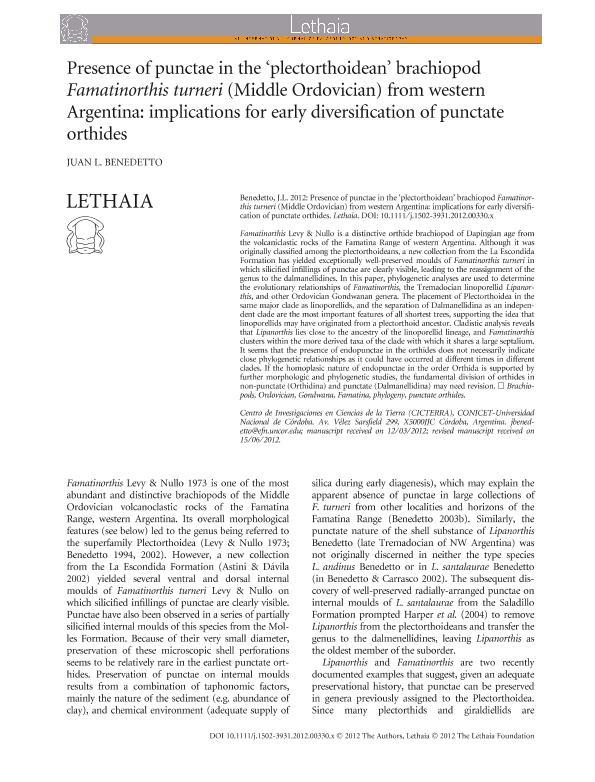Artículo
Presence of punctae in the ‘plectorthoidean’ brachiopod Famatinorthis turneri (Middle Ordovician) from western Argentina: implications for early diversification of punctate orthides
Fecha de publicación:
08/2012
Editorial:
Wiley
Revista:
Lethaia
ISSN:
0024-1164
Idioma:
Inglés
Tipo de recurso:
Artículo publicado
Clasificación temática:
Resumen
Famatinorthis Levy & Nullo is a distinctive orthide brachiopod of Dapingian age from the volcaniclastic rocks of the Famatina Range of western Argentina. Although it was originally classified among the plectorthoideans, a new collection from the La Escondida Formation has yielded exceptionally well-preserved moulds of Famatinorthis turneri in which silicified infillings of punctae are clearly visible, leading to the reassignment of the genus to the dalmanellidines. In this paper, phylogenetic analyses are used to determine the evolutionary relationships of Famatinorthis, the Tremadocian linoporellid Lipanorthis, and other Ordovician Gondwanan genera. The placement of Plectorthoidea in the same major clade as linoporellids, and the separation of Dalmanellidina as an independent clade are the most important features of all shortest trees, supporting the idea that linoporellids may have originated from a plectorthoid ancestor. Cladistic analysis reveals that Lipanorthis lies close to the ancestry of the linoporellid lineage, and Famatinorthis clusters within the more derived taxa of the clade with which it shares a large septalium. It seems that the presence of endopunctae in the orthides does not necessarily indicate close phylogenetic relationships as it could have occurred at different times in different clades. If the homoplasic nature of endopunctae in the order Orthida is supported by further morphologic and phylogenetic studies, the fundamental division of orthides in non-punctate (Orthidina) and punctate (Dalmanellidina) may need revision. h Brachiopods, Ordovician, Gondwana, Famatina, phylogeny, punctate orthides.
Palabras clave:
Brachiopods
,
Phylogeny
,
Famatina
,
Ordovician
Archivos asociados
Licencia
Identificadores
Colecciones
Articulos(CICTERRA)
Articulos de CENTRO DE INVEST.EN CS.DE LA TIERRA
Articulos de CENTRO DE INVEST.EN CS.DE LA TIERRA
Citación
Benedetto, Juan Luis Arnaldo; Presence of punctae in the ‘plectorthoidean’ brachiopod Famatinorthis turneri (Middle Ordovician) from western Argentina: implications for early diversification of punctate orthides; Wiley; Lethaia; 46; 2; 8-2012; 170-179
Compartir
Altmétricas




